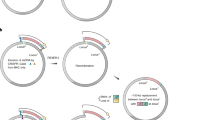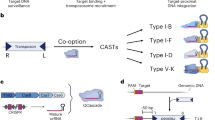Abstract
By following a logical set of selection rules, a dodecadeoxyribonucleotide with potentially unique coding properties was designed and synthesized. This dodecamer is palindromic throughout 2/3 of its length, it self–anneals to generate multimers with 4bp single–stranded extensions, and, upon treatment with DNA ligase, it can be covalently joined to any double–stranded DNA molecule previously digested with EcoRI. The presence within our polymerized dodecamer of cleavage sites for endonucleases HaeIII and Bal I facilitated the monitoring of polymerization, ligation, and cloning. The polymerized dodecamer was positioned downstream from the lac UV5 promoter in a frameshift plasmid, pPCφ1, chosen to ensure that a particular translational reading frame would be utilized.
Cloned, synthetic palindromic DNA was stable in vivo, but only when its size did not exceed 120 bp. The apparent lack of viability of cells harboring plasmids with inserts longer than 120 bp appears to be solely attributable to the palindromic character of the DNA. An alternative approach that has shown promise as a way of increasing the cellular content of a highly palindromic sequence is to interrupt the sequences with nonpalindromic DNA. This strategy was used to construct stable plasmids with 30–90 copies of a palindromic sequence that would not otherwise persist in E. coli.
This is a preview of subscription content, access via your institution
Access options
Subscribe to this journal
Receive 12 print issues and online access
$209.00 per year
only $17.42 per issue
Buy this article
- Purchase on Springer Link
- Instant access to full article PDF
Prices may be subject to local taxes which are calculated during checkout
Similar content being viewed by others
References
Goeddel, D.V., Kleid, D.G., Bolivar, F., Heynecker, H.L., Yansura, D.G., Crea, R., Hirose, T., Kraszewski, A., Itakura, K., and Riggs, A.D. 1979. Expression in Escherichia coli of chemically synthesized genes for human insulin. Proc. Nat. Acad. Sci. (USA) 76: 106–110.
Martial, J.A., Hallewell, R.A., Baxter, J.D., and Goodman, H.M. 1979. Human growth hormone: complementary DNA cloning and expression in bacteria. Science 205: 602–607.
Goeddel, D.V., Heynecker, H.L., Hozumi, T., Arentzen, R., Itakura, K., Yansura, D.G., Ross, M.J., Miozzari, G., Crea, R., and Seeburg, P.H. 1979. Direct expression in Escherichia coli of a DNA sequence coding for human growth hormone. Nature 281: 544–548.
Fraser, T.H. and Bruce, B.J. 1978. Chicken ovalbumin is synthesized and secreted by Escherichia coli. Proc. Nat. Acad. Sci. (USA) 75: 5936–5940.
Mercereau-Puijalon, O., Royal, A., Cami, B., Garapin, A., Krust, A., Gannon, F., and Kourilsky, P. 1978. Synthesis of an ovalbumin-like protein by Escherichia coli K12 harbouring a recombinant plasmid. Nature 275: 505–510.
Itakura, K., Hirose, T., Crea, R., Riggs, A.D., Heynecker, H.L., Bolivar, F., and Boyer, H.W. 1977. Expression in Escherichia coli of a chemically synthesized gene for the hormone somatostatin. Science 198: 1056–1063.
Emtage, J.S., Tacon, W., Catlin, G.H., Jenkins, B., Porter, A.G., and Carey, N.H. 1980. Influenza antigenic determinants are expressed from haemagglutinin gene cloned in Escherichia coli. Nature 283: 171–174.
Doel, M.T., Eaton, M., Cook, E.A., Lewis, H., Patel, T., and Carey, N.H. 1980. Expression in E. coli of synthetic repeating polymeric gene coding for poly (L-aspartyl-L-phenylalanine). Nucleic Acid Res. 8: 4575–4592.
Kangas, T.T., Cooney, C.L., and Gomez, R.F. 1982. Expression of a proline-enriched protein in Escherichia coli. Appl. Environ. Microbiol. 43: 629–635.
Brutlag, D., Fry, K., Nelson, T., and Hung, P. 1977. Synthesis of hybrid bacterial plasmids containing highly repeated satellite DNA. Cell 10: 509–519.
Sadler, J.L., Tecklenburg, M., and Betz, J.L. 1980. Plasmids containing many tandem copies of a synthetic lactose operator. Gene 8: 279–300.
Collins, J. 1980. Instability of palindromic DNA in Escherichia coli. Symposia on Quantitative Biology 45: 409–416.
Collins, J., Volckaert, G., and Nevers, P. 1982. Precise and nearly-precise excision of the symmetrical inverted repeats of Tn 5: Common features of recA-independent deletion events in Escherichia coli. Gene 19: 139–146.
Lilley, D.M.J. 1981. In vivo consequences of plasmid topology. Nature 292: 380–382.
Hagan, C.E., and Warren, G.J. 1982. Lethality of palindromic DNA and its use in the selection of recombinant plasmids. Gene 19: 147–151.
Itakura, J., Buhl, C.P., Katagiri, N., Michniewicz, J.J., Wightmin, R.H., and Narang, S.A. 1973. Can. J. Chem. 51: 3649–3651.
Donelson, J.E., Burrell, B.G., Weith, H.L., Küssel, H., and Schott, H. 1975. Eur. J. Biochem. 58: 303–315.
Charnay, P., Perricaudet, M., Galibert, F., and Tiollais, P. 1978. Bacteriophage Lambda and plasmid vectors, allowing fusion of cloned genes in each of the three translation phases. Nucleic Acid Res. 5: 4479–4494.
Maxam, A.M. and Gilbert, W. 1977. A new method of sequencing DNA. Proc. Nat. Acad. Sci. (USA) 74: 560–564.
Hallewell, R.A. and Sherratt, D.J. 1976. Isolation and characterization of ColE2 plasmid mutants unable to kill colicin-sensitive cells. Mol. Gen. Genet. 146: 239–245.
Yang, H.L., Ivashkiv, L., Chen, H.Z., Zubay, G., and Cashel, M. 1980. Cell-free coupled transcription-translation system for investigation of linear DNA segments. Proc. Nat. Acad. Sci. (USA) 77: 7029–7033.
Kacinski, B.M., Sancar, A., and Rupp, W.D. 1981. A general approach for purifying proteins encoded by cloned genes without using a functional assay: Isolation of the uvrA gene product from radiolabeled maxicells. Nucleic Acid Res. 9: 4495–4508.
Ish-Horowicz, D. and Burke, J.F. 1981. Rapid and efficient cosmid cloning. Nucleic Acid Res. 9: 2989–2998.
Marians, K.J., Wu, R., Stawinski, J., Hozumi, T., and Narang, S.A. 1976. Cloned synthetic lac operator DNA is biologically active. Nature 263: 744–748.
Sadler, J.R., Betz, J.L., and Tecklenburg, M. 1978. Cloning of chemically synthesized lactose operators II. EcoRI-linked operators. Gene 3: 211–232.
Szostak, J.W. and Blackburn, E.H. 1982. Cloning yeast telomeres on linear plasmid vectors. Cell 29: 245–255.
Struhl, K., Cameron, J.R., and Davis, R.W. 1976. Functional genetic expression of eucaryotic DNA in Escherichia coli. Proc. Nat. Acad. Sci. (USA) 73: 1471–1475.
Boyer, H.W. and Roulland-Dussoix, D. 1969. A complementation analysis of the restriction and modification of DNA in Escherichia coli. J. Mol. Biol. 41: 459–472.
Williams, B.G. and Blattner, F.R. 1979. Construction and characterization of the hybrid bacteriophage lambda Charon vectors for DNA cloning. J. Virol. 29: 555–575.
Bolivar, F., Rodriguez, R., Greene, P.J., Betlach, M., Heynecker, H.L., Boyer, H.W., Crosa, J., and Falkows, S. 1977. Contruction and characterization of new cloning vehicles, a multipurpose cloning system. Gene 2: 95–113.
Hartley, J.L. and Gregori, T.J. 1981. Cloning multiple copies of a DNA segment. Gene 13: 347–353.
Gough, G.R., Singleton, C.K., Weith, H.L., and Gilham, P. 1979. Protected deoxyribonucleoside-3′ aryl phosphodiesters as key intermediates in polynucleotide synthesis. Construction of an icosanucleotide analogous to the sequence at the ends of Rous Sarcoma Virus 35S RNA. Nucleic Acid Res. 6: 1557–1570.
Goodman, H.M. and MacDonald, R.J. 1980. Cloning of hormone genes from a mixture of cDNA molecules. Methods Enzymol. 68: 75–91.
Blattner, F.R., Blechl, A.E., Denniston-Thompson, K., Faber, H.E., Richards, J.E., Slightom, J.L., Tucker, P.W., and Smithies, O. 1978. Cloning human fetal δ globin and mouse α-type globin DNA: Preparation and screening of shotgun collections. Science 202: 1279–1284.
Clewell, D.B. and Helinski, D.R. 1970. Properties of a supercoiled deoxyribonucleic acid-protein relaxation complex and strand specificity of the relaxation event. Biochem. 9: 4428–4440.
Cohen, S.N., Chang, A.C.Y., and Hsu, Z. 1972. Nonchromosomal antibiotic resistance in bacteria: Genetic transformation of Escherichia coli by R-factor DNA. Proc. Nat. Acad, Sci. (USA) 69: 2110–2114.
Miller, J.H. 1978. Experiments in Molecular Genetics, Cold Spring Harbor Laboratory, Cold Spring Harbor, NY, 1972, pp. 433.
Author information
Authors and Affiliations
Rights and permissions
About this article
Cite this article
Gupta, S., Weith, H. & Somerville, R. Biological Limitations on the Length of Highly Repetitive DNA Sequences that May be Stably Maintained within Plasmid Replicons in Escherichia coli. Nat Biotechnol 1, 602–609 (1983). https://doi.org/10.1038/nbt0983-602
Received:
Accepted:
Issue Date:
DOI: https://doi.org/10.1038/nbt0983-602



